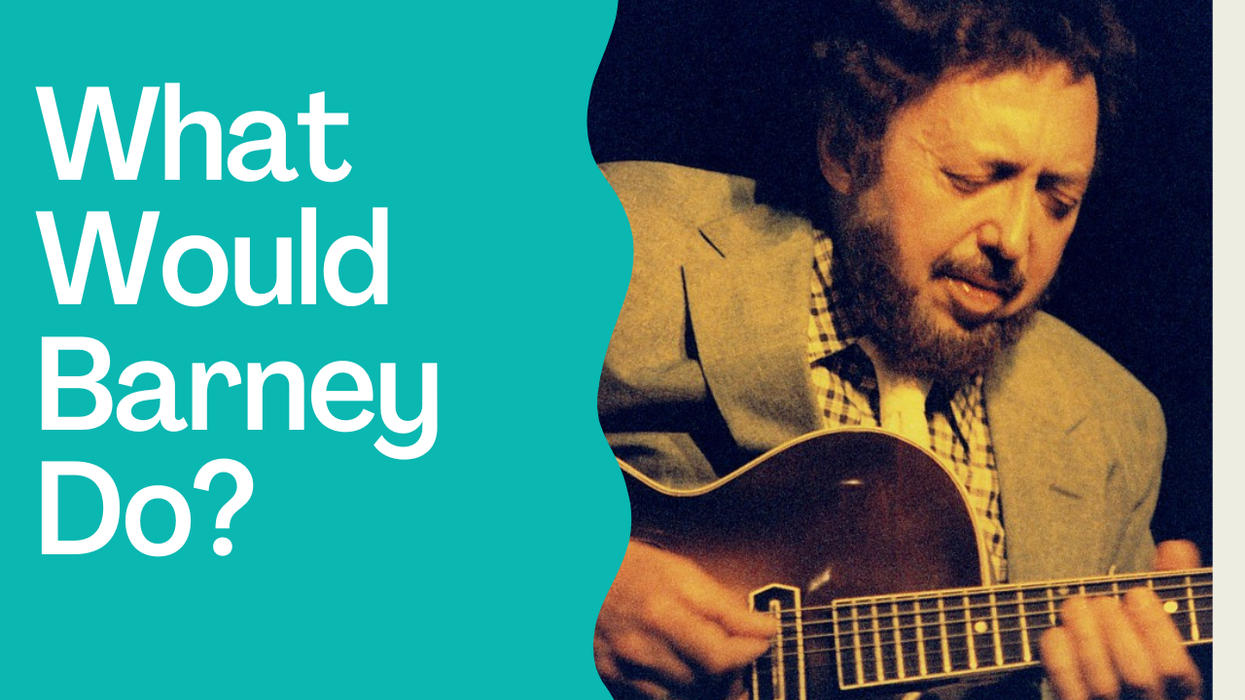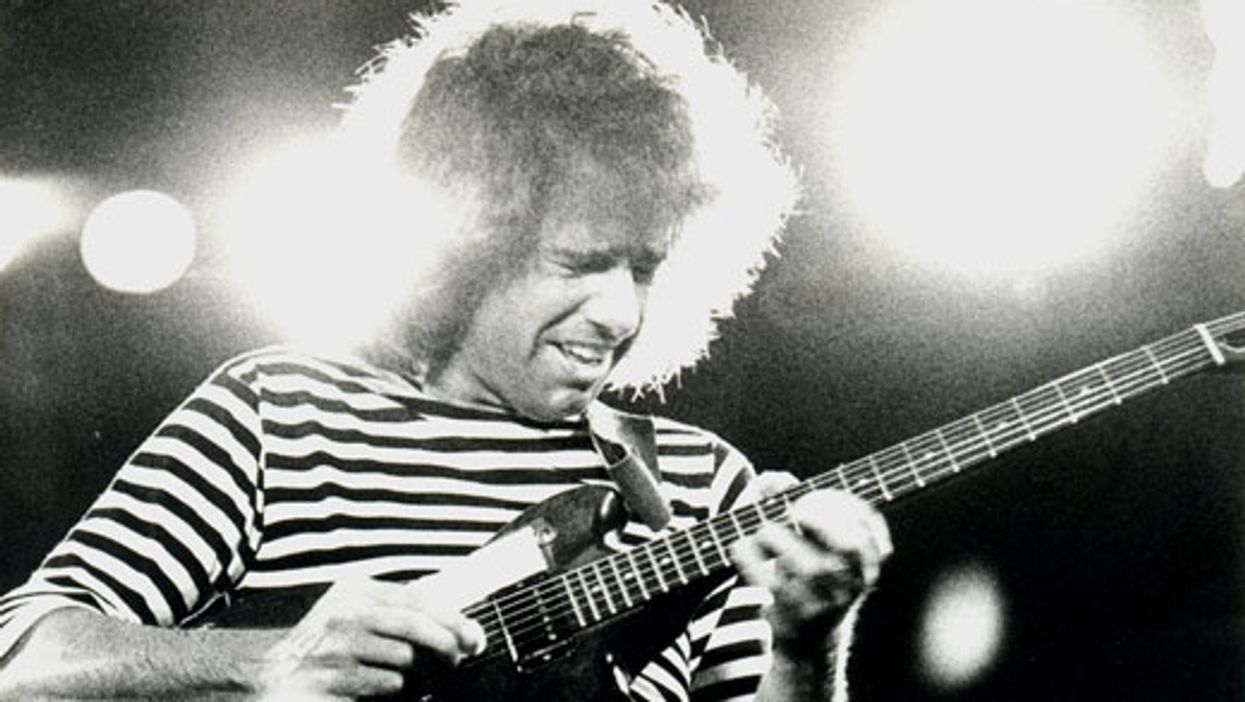Yeah. The guy means business.
Let’s take a look at some key elements of Kessel’s style by exploring one particular tune: his terrific live arrangement of Jimmy Van Heusen’s “Here’s That Rainy Day,” which I recently watched on YouTube. It features various hallmarks of his playing, and it’s where we’ll get all the following music examples.
Before getting started, note that Kessel used a pick almost exclusively, very rarely playing fingerstyle. All examples in this lesson are played with a pick.
Kessel’s Chordal Cool
When playing chords, Kessel frequently used his fretting-hand thumb, something unorthodox for most jazz players of the day. In fact, he would regularly use it to fret both the 6th and 5th strings simultaneously. In the first measure of Ex. 1, note how this enables him to include the low A when playing the D7b9/A. This type of voicing is rare in jazz guitar, as the resulting fourth interval between the lowest two notes creates a thicker sound most jazz players tend to stay away from. However, in Kessel’s hands, it just works.
Kessel was a master of tastefully filling in the open spaces which naturally occur in melodies. In the midst of his solo chord/melody intro, he extends a bar of Gmaj7 into two with a series of triads over a G drone, a favorite arranging technique of his (Ex. 2). Notice how he instead uses a G7 tonality in order to segue to the approaching Cm7. Note that this passage is again made possible by the use of his fretting-hand thumb on the 6th string.
Kessel’s facility with chord voicings is certainly not uncommon among jazz greats, but he had various Kessel-isms that he’d frequently draw upon in his playing. No lesson about Kessel would be complete without the minor 7th chord move in Ex. 3. Notice how he climbs up and down various extensions along the way—the 9 (E) and 11 (G)—before briefly shifting up a half-step to dramatic effect. You’ll find this figure can be applied in all sorts of situations where minor 7th chords appear, and Kessel uses it quite a bit.
Bend It Like Barney
A rock ’n’ roll-style blues lick in a jazz lesson may be a surprise, but let’s look at how Kessel effectively made this a part of his arsenal like few others of his day. In Ex. 4 he launches into a tasty blues lick over a classic IIIm–VI–IIm–V turnaround in the key of G major. While primarily drawing from the G blues scale (G–A–Bb–C–Db–D–F), he also includes a few notes from the G major scale (G–A–B–C–D–E–F#), most notably in the initial bend. Give this phrase a whirl, even if you’ve played these sorts of blues licks before. Remember, it’s how and where he’s using it that makes it so effective.
And, hey, when’s the last time you saw a jazz guitarist break a string while bending? As you’ll see in the following video, Kessel sure did…
… and it didn’t faze him one bit. It’s worth noting that as a member of the Wrecking Crew, the legendary group of first-call session musicians, he played on many popular songs throughout the 1960s (including an appearance on the classic Beach Boys’ album Pet Sounds). So, he was hip to what was going on at the time, and was involved in all sorts of musical situations outside of jazz.
Nifty Lines
Kessel was a master of improvisation, crafting lightning-quick jazz lines on the fly. Here’s one which occurs just after the above blues phrase (Ex. 5). Sure, it’s a common approach in jazz to anticipate a chord before it arrives, but here Kessel uses just about the entire second measure to foreshadow the Fm7 before it ultimately makes its entrance in measure three. His left hand doesn’t appear in the video, but you do get a close-up view of his use of sweep picking.
Kessel would also fearlessly venture into harmonizing his lines, most often using major and minor thirds. In Ex. 6 he begins with a quick ascending figure; then, for the descending figure which follows, be sure to use only your first and second fretting-hand figures on the high two strings, as he does, to keep the fingering nice and smooth.
In addition, Kessel deftly wove lines in between chords to build excitement. During the tune’s free-time intro, he adds some beautiful legato flourishes (Ex. 7).
Not surprisingly, Kessel was quite creative when fashioning endings for his arrangements, and this tune is no exception. After a slick fretting-hand thumb slide, he careens through a series of chromatically descending chordal stabs. Then, true to form, he ends with that very same thumb fretting the two lowest strings of the final chord (Ex. 8).
Wait— No Rig Rundown?!
Of course, like most jazzers of the day, Kessel simply plugged his guitar directly into an amp — in his case, a Gibson BR–3. But his guitar was rather unique — a modified Gibson ES–350 from 1946. So we’ll give BK the last word, as he gives you the inside scoop on his favorite axe.










![Rig Rundown: Russian Circles’ Mike Sullivan [2025]](https://www.premierguitar.com/media-library/youtube.jpg?id=62303631&width=1245&height=700&quality=70&coordinates=0%2C0%2C0%2C0)













